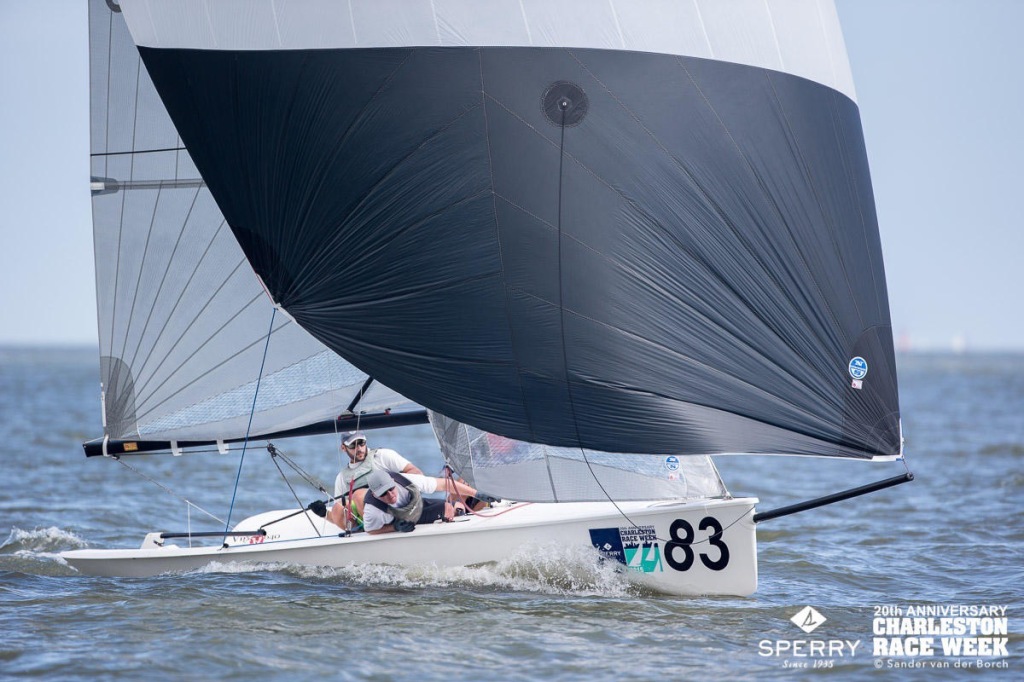Article by Zeke Horowitz
While the weather in Charleston certainly didn’t live up to the hype, the racing and southern hospitality definitely did. Despite some less than ideal conditions, we were able to get in eight races on the Viper course and came away with many great memories of fun racing, and fun social gatherings at the beach party! My team came away with some very valuable lessons about how to keep to the boat moving as fast as possible.
The biggest lesson I learned about the Viper is how sensitive it is to the “mode” you are sailing in, both upwind and downwind. I was very conscious on the upwind legs about making sure that I was keeping the jib pressed and the bow down to generate as much power as possible. This “press mode” quickly turned into a very high and fast mode when the breeze was relatively light and the water was flat. I made sure that if the boat ever felt like it was flattening out too much, I would gently pull the tiller towards me and pull the main in that last inch to load the rig back up. Once everything felt loaded, I would hike the boat flat and gently let the helm down to get as much height as possible. The boat loves to have the main trimmed hard so I was constantly checking my leech tell-tales and making sure that I had the mainsheet as tight as possible without stalling.
As the breeze came up and we became overpowered, the mode switched from the bow down press mode, to the heeled over pinchy mode – more like a normal keel boat. The boat can feel like it wants to go into the “vang sheet bow down super Laser hiking” mode, but you end up just reaching around the race-course because you have to give up so much height to flatten the boat out. So once the breeze was up in the mid-teens, I made sure to only let the main out about 3-5 inches (with plenty of vang on) and feather until there was a small bubble in the luff of the jib. From there, I would just try to maintain a steady level of heel by working the mainsheet back in or pulling the tiller towards me to induce some leeward heel when we sailed into a small lull. The big thing to be careful of when sailing in this mode is big chop. It was imperative that my crew was calling the big chop because you don’t want to sail in this mode with massive slop on the bow.
I found that the downwind mode was remarkably similar regardless of the breeze strength. We had breeze range from about 3 kts to maybe 14 kts throughout the regatta, and I always found that I was looking for the same feel. The boat felt best with about 5 degrees of leeward heel. If we sailed any lower, the boat flattened out completely and we lost a lot of speed, and if we sailed much higher, we would be way heeled to leeward with too much helm. So I really concentrated on feeling the boat as it heeled and flattened, and made sure to turn the boat to maintain that constant level of small heel (I turned down if the boat to heeled too much, and back up if the boat flattened out too much). Boats around us tried sailing lower in the light air, but we found it to be much better to sail a little bit of extra distance at a higher speed with more power. I also found it to be quite good for me, as the helmsman, to be sitting down on the floor of the boat when it was light air, and let my spinnaker trimmer sit up on the rail. This allowed us to sail a tiny bit lower because my weight was more centered (inducing a bit of leeward heel), and my trimmer could move his weight in and out a lot to help me steer the boat as he felt the boat heel.
We found that fore/aft weight placement was very important on the upwind legs. We made sure to have our jib trimmer sit all the way forward (in front of the shrouds) until such time as we absolutely needed him fully hiking. We had a mode where our middle crew and I would be fulling hiking with the forward crew still sitting in front of the shroud. If we were still overpowered, then the forward crew would pop behind the shroud and keep hiking. We felt fast with the weight as far forward as possible.
We’ve got many more lessons to learn. A big lesson we learned the HARD way, was to be sure to check your pole-out line where it ties onto the back of the pole. We had the carbon wear through right where the knot is. Turns out it is much faster to use a spinnaker downwind than it is to sail wing-on-wing with a jib!!!
Editor’s note: Zeke Horowitz just finished second at Charleston Race Week and has some tips to share on making a viper go. He is new to the Viper Class and also a new member of the North Sails One-Design team. A College-of Charleston graduate with years of yacht club sailing directing under his belt, Zeke is a great addition to the Viper 640 family. He’s also available to share other tips and you can contact him at zeke.horowitz@northsails.com.



